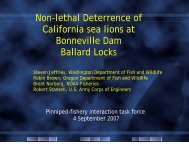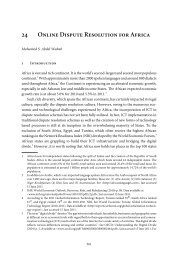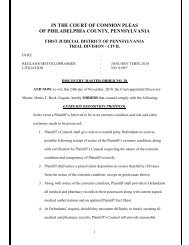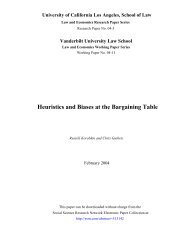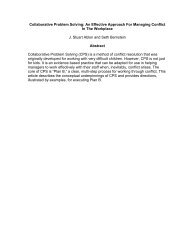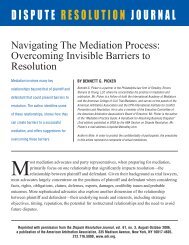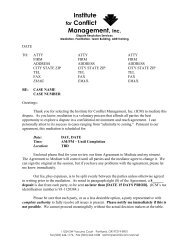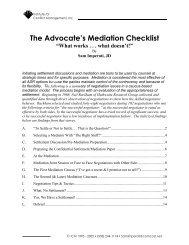17 e-Mediation - Mediate.com
17 e-Mediation - Mediate.com
17 e-Mediation - Mediate.com
You also want an ePaper? Increase the reach of your titles
YUMPU automatically turns print PDFs into web optimized ePapers that Google loves.
<strong>17</strong> e-<strong>Mediation</strong><br />
– Parties gain access to mediator expertise beyond that which might be available in any<br />
given geographical region. 26<br />
– The issue of cost remains unresolved. There are different models for pricing e-mediation<br />
services, and these are often no different than face-to-face services. However, there<br />
certainly is enhanced cost effectiveness, given that parties save on travel cost and perhaps<br />
do not dedicate costly work time to a mediation process.<br />
3.3.1.2 Process Advantages<br />
– In asynchronous processes, the slowed-down pace can allow the mediator a more<br />
intentional application of the mediator’s toolbox. This is enhanced by enhanced<br />
opportunities for nuance and subtlety. Mediators might find it easier to tweak and<br />
reframe messages. They can create opportunities for, light, behind the scenes contact<br />
with each party to a greater degree than face-to-face processes allow, as private <strong>com</strong>munication<br />
reduces threats to perceived neutrality. Working with asynchronous<br />
methods, mediators can conduct simultaneous caucusing, saving process-time. Further<br />
utility can be achieved due to the elimination of those caucuses which face-to-face<br />
mediators find they conduct for the sole purpose showing even-handedness. 27<br />
– Records are preserved and reviewable, allowing for more seamless processes and joint<br />
frames of reference.<br />
– Text <strong>com</strong>munication, as a vehicle for mediation has its pros and cons and this issue is<br />
oft-debated in the literature. However it is, in practice, the most prevalent form of<br />
<strong>com</strong>munication in e-mediation. Some of the benefits associated with text <strong>com</strong>munication<br />
for e-mediation are that it often minimizes the effects of “good talkers” gaining<br />
the upper hand or of dominant figures causing others to reduce their participation<br />
levels. 28 Additionally, the emotion-limiting nature of text <strong>com</strong>munication has been<br />
suggested as an advantage in e-negotiation and e-mediation as reducing confrontational<br />
dynamics, although this is certainly issue for debate. 29<br />
– Parties and mediators can engage in discussion without the immediate time pressure<br />
and other dynamics associated with synchronous, face-to-face conversations.<br />
26 Katsh & Rifkin (2000), discuss the basic requirements of any ODR system as being convenience, trust and<br />
expertise. We have noted the first two as being inherent in many models of providing e-mediation services.<br />
The third, a different kettle of fish altogether, is discussed in Ebner, chapter 11 in this book.<br />
27 C. Rule, New Mediator Capabilities in Online Dispute Resolution, 2000. Available at ,<br />
last accessed 22 May 2011.<br />
28 L.L. Thompson, The Mind and Heart of the Negotiator, (2nd ed.) Prentice Hall 2001.<br />
29 See R.M. Victorio, “Internet Dispute Resolution (IDR): Bringing ADR into the 21 st Century”, Pepp. Disp.<br />
Resol. L. J. (2000) 1; N. Ebner et al., “You’ve Got Agreement: Negoti@ting Via Email”, in C. Honeyman,<br />
J. Coben & G. De Palo (eds.), Rethinking Negotiation Teaching: Innovations for Context and Culture, St. Paul,<br />
MN, DRI Press 2009.<br />
377



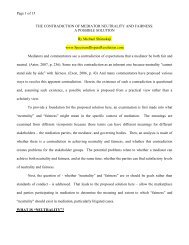

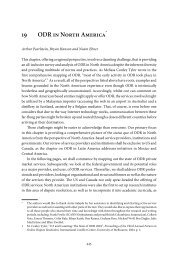
![Settlement Agreement Form [Agreement] - Mediate.com](https://img.yumpu.com/50682143/1/190x245/settlement-agreement-form-agreement-mediatecom.jpg?quality=85)
